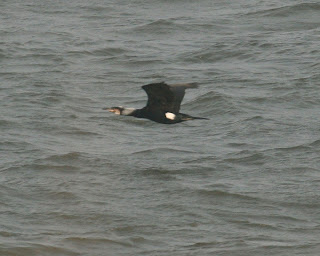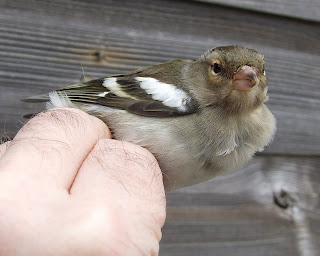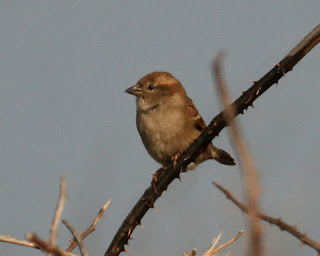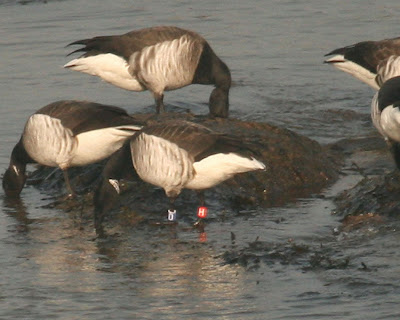
No new birds ringed today but P459332 the oldest known British Meadow Pipit (right) (see 21st March) was again availing itself of the free meal in the potter traps.
Latest news from the island


There seems to be an increase of Turnstones at the moment as these waders prepare to move north to breed and Purple Sandpipers were counted at a healthy 18.
 The 3 Wheatears (left) on the island today proved to be all females of the nominate race oenanthe.
The 3 Wheatears (left) on the island today proved to be all females of the nominate race oenanthe.


 Five House sparrows (left) came down on the bushes but did not stay too long while 2 Starlings did not even alight at all nor did a Wood Pigeon (below) that flew south passed the light (not a bird we would bother to photograph on the mainland !). The resident Mallards have increased to 9 drakes inhabiting the main island pond.
Five House sparrows (left) came down on the bushes but did not stay too long while 2 Starlings did not even alight at all nor did a Wood Pigeon (below) that flew south passed the light (not a bird we would bother to photograph on the mainland !). The resident Mallards have increased to 9 drakes inhabiting the main island pond.

 The Brent are now slightly down in numbers on the winter peak, but the Dublin ringed bird (left) was showing well.
The Brent are now slightly down in numbers on the winter peak, but the Dublin ringed bird (left) was showing well.Another male Northern Wheatear stayed the day, this time keeping exclusively to the north end of the island and at one time sitting on top of the sea watching hide (right).
Trapped for ringing: 5 Goldcrests, 2 Blackbirds, 2 Robins, 1 Song Thrush
(DB,CJ,KMc et al) photo CJ


 Still only a few other passerines, including a single Blackbird grounded, with 3 Pied Wagtails, 3 Goldfinches and 2 Greenfinches passing over.
Still only a few other passerines, including a single Blackbird grounded, with 3 Pied Wagtails, 3 Goldfinches and 2 Greenfinches passing over.
 swimming in the Dee with Gulls! A tricky identification problem caused by a bird in distress. Twenty two Red-breasted Mergansers were off the West Hoyle with 18 Great Crested Grebes but no sign of any Little Gulls.
swimming in the Dee with Gulls! A tricky identification problem caused by a bird in distress. Twenty two Red-breasted Mergansers were off the West Hoyle with 18 Great Crested Grebes but no sign of any Little Gulls.Not to mention all of the birds he has found, seen and ringed on Hilbre in his 50 years visiting the island.
Whilst he loved birds and all aspects of nature – he was also a people person – he simply loved people and in particular he loved children and their enthusiasm and eagerness to learn which was matched by his own undiminished passion for life right to the end. He lived life at 120mph – and that was not just the speed he returned home from work every Friday night – before heading to his beloved island with his adoring boys.
He has been taken too soon at just 65 – but he lived every minute of every day and we are so proud to have known him so well and to have shared the three loves in life – his family, his friends and his island with everyone at the Obs.
Thanks to everyone for all their support at this difficult time.
“Dad you never did walk alone and you never will”
Chris and Steve Williams
Pete Williams at the opening of the Old Obs in 1962 (third from left)


 few times to the east of the island.
few times to the east of the island.